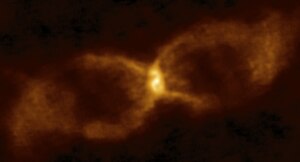| Observation data Epoch J2000.0 Equinox J2000.0 | |
|---|---|
| Constellation | Vulpecula |
| Right ascension | 19h 47m 38.0s[2] |
| Declination | +27° 18′ 48″[2] |
| Apparent magnitude (V) | max 2.6[2] |
| Characteristics | |
| B−V color index | 0.7[3] |
| Variable type | unknown[3] |
| Astrometry | |
| Distance | 10000+3000 −2000[4] ly (3200+900 −600[4] pc) |
| Details | |
| Luminosity | 0.9[3] L☉ |
| Temperature | 14,000 – 100,000[3] K |
| Other designations | |
| Database references | |
| SIMBAD | data |
CK Vulpeculae (also Nova Vulpeculae 1670) is an object whose exact nature is unknown.[4] It was once considered to be the oldest reliably-documented nova. It consists of a compact central object surrounded by a bipolar nebula.
Models suggest CK Vulpeculae may not be a classic nova; rather it may be classified as a luminous red nova which is the result of two main sequence stars colliding and merging. A 2018 study found it was most likely the result of an unusual collision of a white dwarf and a brown dwarf. A 2020 article ruled out this proposed mechanism and proposes that CK Vulpeculae is an intermediate luminosity optical transient, i.e. an object in the luminosity gap between supernovae and novae.[4]
- ^ "Through the Hourglass". www.eso.org. Retrieved 8 October 2018.
- ^ a b c Cite error: The named reference
downeswas invoked but never defined (see the help page). - ^ a b c d Cite error: The named reference
Evans2016was invoked but never defined (see the help page). - ^ a b c d Cite error: The named reference
banewas invoked but never defined (see the help page). - ^ Morton, Wagman (2003). Lost Stars. Blacksburg, Virginia: McDonald and Woodward. p. 494. ISBN 978-0-939923-78-6.
